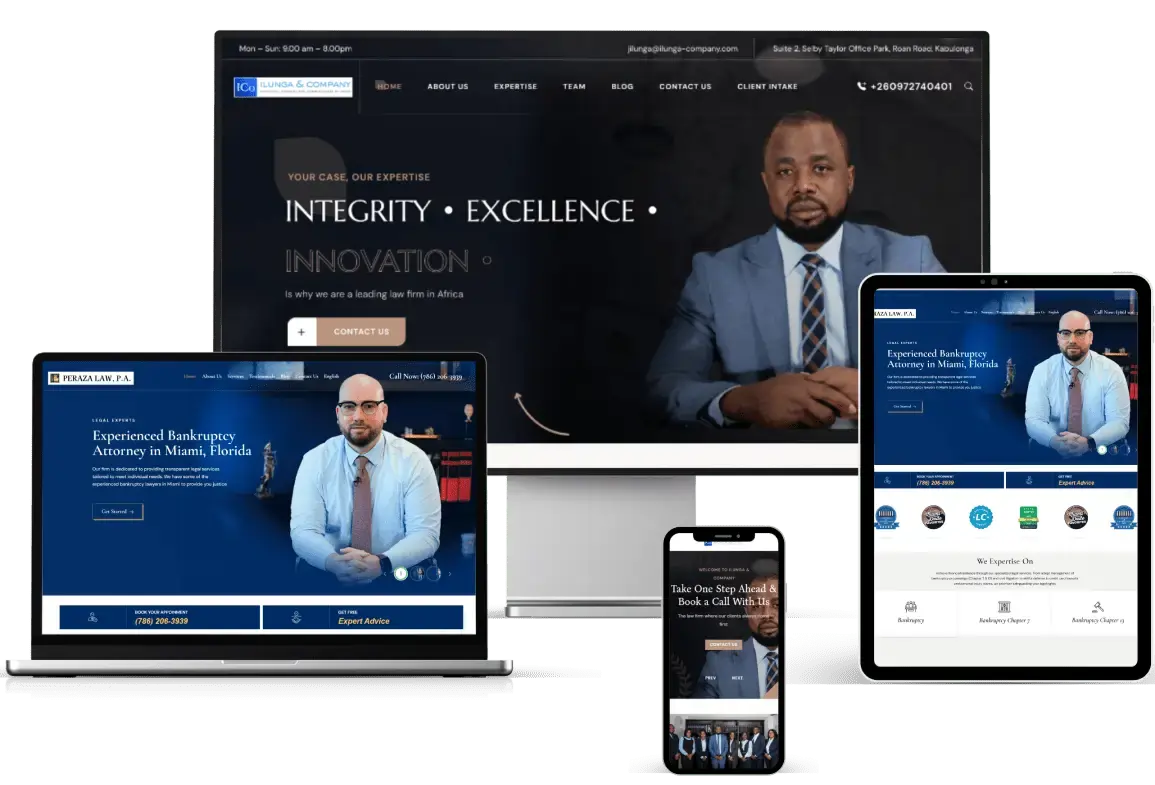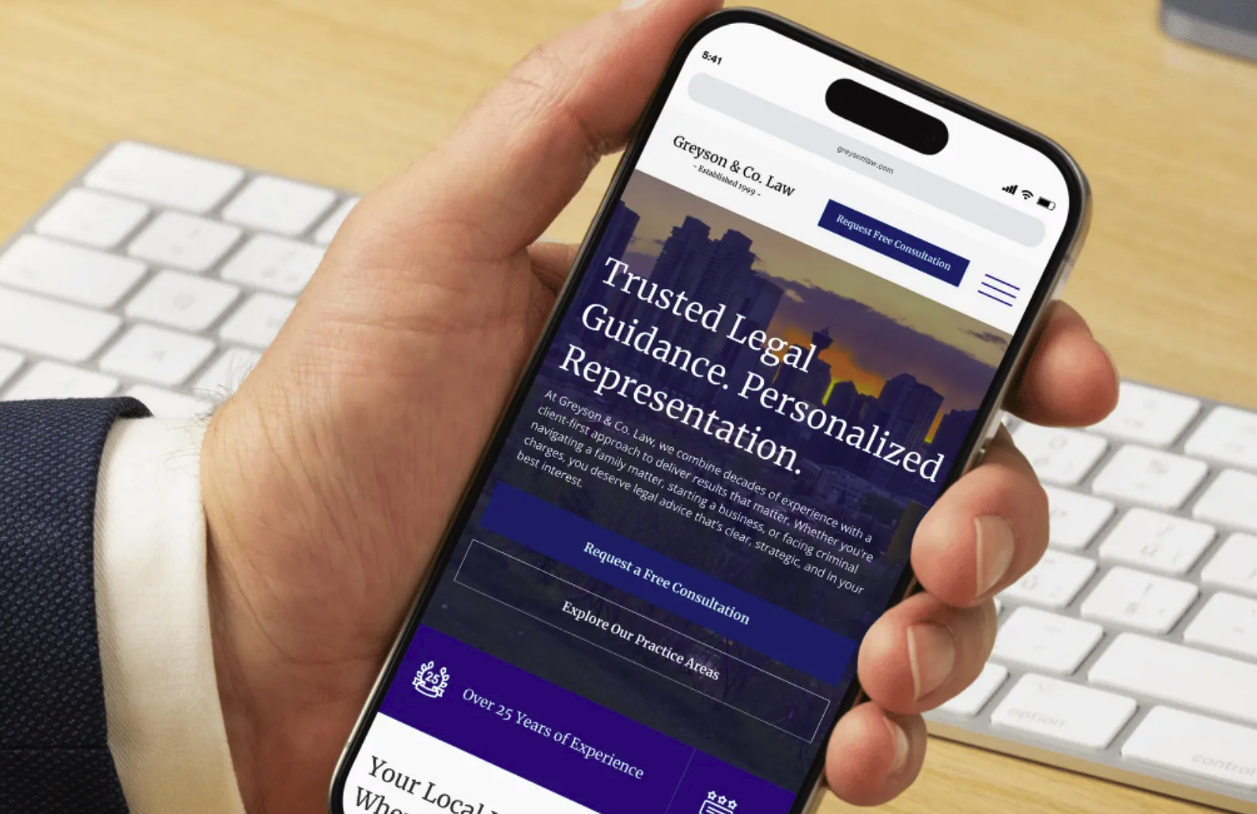In the legal profession, trust isn't just important – it's everything. When potential clients land on your law firm's website, they're often facing stressful situations that require immediate legal help. Your website has mere seconds to convince them that you're the right attorney to handle their case. 88% of online consumers are less likely to return to a website after a bad experience, making your first impression absolutely critical for client conversion success.

Attorney and law firm websites displayed on multiple devices demonstrating mobile responsive design and client engagement features
The days of relying solely on referrals and Yellow Pages listings are long gone. 97% of people now use online searches to find legal services, and 75% of consumers judge a law firm's credibility based on their website design alone. Your website isn't just a digital brochure – it's your most powerful client acquisition tool, working 24/7 to attract, engage, and convert potential clients into paying customers.
Modern law firms that understand website conversion optimization see dramatic improvements in their client acquisition rates. Well-optimized legal websites can achieve conversion rates between 5% and 15%, compared to poorly designed sites that often convert less than 2% of visitors. The difference between success and failure often comes down to implementing the right combination of trust signals, user experience optimization, and strategic calls-to-action.
Building trust through your website requires understanding how potential clients evaluate legal services online. When someone needs a lawyer, they're often dealing with significant stress, financial concerns, or life-changing situations. Your website must immediately communicate competence, reliability, and understanding of their unique challenges.
Visual credibility starts with professional design. Clean layouts, consistent branding, and high-quality imagery create an immediate impression of professionalism. Avoid cluttered designs or outdated aesthetics that might suggest your firm isn't keeping up with modern standards. A well-designed website can increase client trust by up to 95% within the first few seconds of a visit.
Professional photography plays a crucial role in humanizing your firm. Include authentic photos of your actual attorneys and staff, not generic stock images. Detailed attorney bios with education credentials, years of experience, and personal touches help potential clients connect with your team. When clients can see the people behind the practice, trust levels increase significantly.
Color psychology and typography choices also impact trustworthiness. Law firms typically benefit from conservative color schemes using blues, grays, and whites, which convey stability and professionalism. However, strategic use of accent colors for calls-to-action can guide visitor attention without compromising the professional appearance.
Trust signals are specific elements on your website that validate your firm's credibility and expertise. Client testimonials are among the most powerful trust signals, with 88% of consumers trusting online reviews as much as personal recommendations. Display authentic testimonials prominently on your homepage and practice area pages, focusing on specific outcomes and client experiences rather than generic praise.
Case results and success stories provide concrete evidence of your legal capabilities. When legally permissible, share specific examples of successful cases, settlement amounts, or positive outcomes you've achieved for clients. Displaying quantifiable results can increase conversion rates by up to 34%, as potential clients want proof that you can deliver similar results for their situations.
Professional credentials and association memberships serve as external validation of your expertise. Display bar association memberships, legal certifications, professional awards, and recognition from respected legal publications prominently on your website. These elements immediately establish your qualifications and differentiate you from less credentialed competitors.
Security badges and privacy statements are increasingly important for building trust online. Display SSL certificates, secure contact form notifications, and clear privacy policies to reassure visitors that their sensitive information will be protected. Given the confidential nature of legal matters, clients need confidence that their communications with your firm will remain secure.

Website speed directly impacts conversion rates, with every additional second of load time resulting in a 7% reduction in conversions. Optimize your images, minimize plugins, and use reliable hosting to ensure your site loads quickly on all devices. Legal emergencies don't wait for slow websites, and neither do potential clients.
Mobile optimization isn't optional – it's essential. Over 60% of legal searches now happen on mobile devices, and Google prioritizes mobile-friendly websites in search results. Your site must display perfectly and function seamlessly across smartphones, tablets, and desktop computers. Test all contact forms, phone number links, and navigation elements on mobile devices regularly.
Mobile-responsive law firm contact form with easy-to-use fields and clear call-to-action on a smartphone screen
Navigation should be intuitive and focused on client needs rather than internal firm structure. Organize your menu around practice areas and services that clients actually search for, not departmental divisions that only make sense internally. Include a prominent search function for visitors looking for specific information quickly.
Page layout and information architecture should guide visitors naturally toward conversion actions. Use clear headings, bullet points, and white space to make content scannable. Visitors spend only 10-20 seconds scanning a page before deciding whether to stay or leave, so critical information must be immediately visible and easily digestible.
Your call-to-action (CTA) buttons are the bridge between visitor interest and client conversion. Generic CTAs like "Contact Us" convert at significantly lower rates than specific, value-driven alternatives. Instead, use action-oriented language that clearly communicates the benefit: "Schedule Your Free Consultation Today," "Get Legal Help Now," or "Speak With an Attorney in 24 Hours."
Creating urgency without appearing pushy requires careful balance. Legal matters often are genuinely time-sensitive, so phrases like "Don't Wait – Deadlines May Apply" or "Limited Consultation Slots Available This Week" can encourage immediate action when used appropriately. However, avoid false urgency or pressure tactics that might undermine trust.
CTA placement strategy significantly impacts conversion rates. Place primary CTAs "above the fold" where visitors can see them immediately, within content sections where interest peaks, and at the end of informative articles where readers are ready to take action. Use contrasting colors that stand out from your general design while maintaining professional appearance.
Risk reduction in your CTAs addresses common client hesitations. Phrases like "Free Initial Consultation," "No Win, No Fee," or "Confidential Case Review" help overcome the natural reluctance people feel when contacting attorneys. Removing perceived risk can increase conversion rates by up to 50% by making that first contact feel safe and commitment-free.
Educational content serves dual purposes: establishing your expertise while addressing client concerns that prevent conversion. Create comprehensive guides, FAQ sections, and blog posts that answer common questions in your practice areas. When potential clients find helpful information on your site, they're more likely to view you as the expert they need.
Local content optimization helps you capture clients in your geographic area. Write about local legal issues, recent changes in state laws, or area-specific challenges your potential clients face. This content not only improves local SEO performance but also demonstrates your understanding of the specific legal landscape where your clients live and work.
Case studies and success stories provide social proof while showcasing your problem-solving abilities. Detail the challenges clients faced, the strategies you employed, and the positive outcomes achieved. Well-crafted case studies can increase conversion rates by up to 185% by helping potential clients envision similar success in their own situations.
Video content increasingly influences conversion decisions, with legal websites featuring attorney videos seeing 53% higher conversion rates. Create short videos introducing your attorneys, explaining complex legal processes, or sharing client success stories. Video humanizes your practice and builds connection more effectively than text alone.
Form optimization can dramatically impact your lead generation success. Reducing contact form fields from four to three can increase conversions by up to 50%. Only ask for essential information initially – name, phone number, email, and brief case description. You can gather additional details during the consultation process.
A/B testing different elements of your website helps identify what works best for your specific audience. Test different headline variations, CTA button colors, form layouts, and page structures to continually improve conversion rates. Law firms that consistently test and optimize their websites see 20% higher conversion rates than those using static designs.
Analytics tracking provides crucial insights into visitor behavior and conversion patterns. Monitor which pages generate the most inquiries, where visitors tend to leave your site, and which traffic sources produce the highest-quality leads. Use this data to continually refine your website strategy and focus resources on the most effective elements.
Security and compliance considerations are particularly important for legal websites. Ensure your contact forms use encryption, your hosting meets security standards, and your privacy policies comply with applicable regulations. Visible security measures can increase form completion rates by up to 42% by addressing visitor concerns about data protection.
Conversion rate tracking should focus on meaningful actions, not just generic "contacts." Track consultation requests, phone calls, email inquiries, and resource downloads separately to understand which types of engagement lead to actual client relationships. The average law firm website conversion rate ranges from 2% to 7%, with top-performing sites achieving rates above 10%.
Lead quality assessment helps you optimize for the right kind of conversions. Track which traffic sources and website elements produce leads that actually become paying clients, not just initial inquiries. Quality leads from organic search typically convert to clients at rates 5-10 times higher than leads from less targeted sources.
Continuous improvement through regular website audits ensures your conversion optimization efforts remain effective. Review your site monthly for broken links, outdated information, slow-loading pages, and conversion bottlenecks. Law firms that conduct quarterly conversion audits see 34% better year-over-year performance than those with static websites.
Your law firm website represents far more than an online presence – it's the cornerstone of your modern client acquisition strategy. By implementing strategic trust signals, optimizing user experience, crafting compelling calls-to-action, and creating valuable content, you can transform your website from a simple informational resource into a powerful client conversion machine.
The legal profession continues evolving as client expectations rise and competition intensifies. Law firms that embrace conversion optimization principles while maintaining the professionalism and trustworthiness essential to legal practice will dominate their markets in the years ahead. Your website should reflect the same attention to detail and client focus that you bring to every legal matter.
Don't let competitors with superior online presence capture the clients you deserve. Every day you delay implementing these proven conversion optimization strategies represents lost opportunities and reduced revenue. The legal market has never been more competitive, but it's also never offered more opportunities for firms that understand how to leverage their websites effectively.
Start implementing these website optimization techniques today, and watch as your legal practice transforms from struggling for new clients to selectively choosing the most desirable cases. Your future success depends not only on your legal expertise but on your ability to connect that expertise with clients who need your services most urgently.
Ready to get your free website that converts visitors into paying clients? Fill out our form today and discover how a professionally optimized law firm website can grow your practice beyond your current expectations.
Fill out the form below and we’ll get back to you within 24 hours to start planning your website.
No pressure.
No obligation.
Just results.
* Only 3 Free Website Slots Available This Month – Secure yours now before they’re gone.